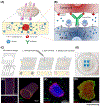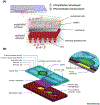Engineering Microphysiological Immune System Responses on Chips
- PMID: 32673588
- PMCID: PMC7368088
- DOI: 10.1016/j.tibtech.2020.01.003
Engineering Microphysiological Immune System Responses on Chips
Abstract
Tissues- and organs-on-chips are microphysiological systems (MPSs) that model the architectural and functional complexity of human tissues and organs that is lacking in conventional cell monolayer cultures. While substantial progress has been made in a variety of tissues and organs, chips recapitulating immune responses have not advanced as rapidly. This review discusses recent progress in MPSs for the investigation of immune responses. To illustrate recent developments, we focus on two cases in point: immunocompetent tumor microenvironment-on-a-chip devices that incorporate stromal and immune cell components and pathomimetic modeling of human mucosal immunity and inflammatory crosstalk. More broadly, we discuss the development of systems immunology-on-a-chip devices that integrate microfluidic engineering approaches with high-throughput omics measurements and emerging immunological applications of MPSs.
Keywords: engineering immune system responses; immune system-on-a-chip; intestinal inflammation; microphysiological systems; systems immunology; tumor immune microenvironment.
Copyright © 2020 Elsevier Ltd. All rights reserved.
Conflict of interest statement
Declaration of Interests
D.H.K. is a scientific founder and equity holder of NanoSurface Biomedical Inc. H.J.K. is a founder of 3D Health Solutions Inc. and holds an equity interest in the company.
Figures





References
-
- Arrowsmith J and Miller P (2013) Trial watch: phase II and phase III attrition rates 2011-2012. Nat Rev Drug Discov 12 (8), 569. - PubMed
Publication types
MeSH terms
Grants and funding
LinkOut - more resources
Full Text Sources
Medical

